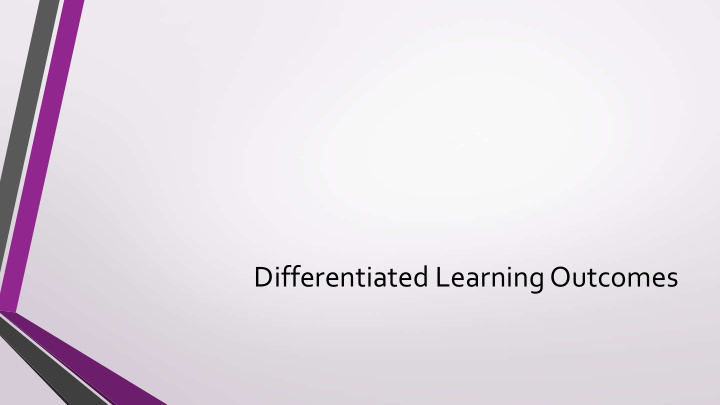



Differentiated Learning Outcomes
Differentiation • All Learners • Some Learners • Few Learners • Extension tasks?
Learning Styles & Objectives
What are Learning Styles?
Honey and Mumford’s Learning Style ACTIVIST (Having and experience) REFLECTOR PRAGMATIST (Review the experience ) (Plan the next step) THEORIST (Conclude from experience)
Objectives? • What should they be based on? • What are you trying to achieve? • They will define what is covered during your presentation • Define the expectations of the presenter – YOU • They must be SMARTER • Lets set some SMART objectives…
Research FEED IN: material • Clear & concise • Relevant & up to date • Accurate • Interesting & appropriate • Structured & complete
Don’t forget to … • remember your audience • be concise • avoid offending those listening • avoid unnecessary jargon and acronyms • illustrate what you mean • BE ENTHUSIASTIC!!!
Your most important tool The Voice
Which tools should I use? • Tools you can handle • Tools that fit the job • Tools that make things easier for you • Tools that make things easier for the listener
First Impressions
First impressions count • Facial • Appearance • Smile, it’s • Dress for your contagious audience not • Laugh, if you’re yourself amused • Don’t overdress • Be natural, if you • If you look out of have a welcoming place - you are natural expression
Teaching Techniques
Teaching Techniques – Can you use them? • Buzz Groups – Little group discussions • Circus Tasks – Each group carries out same tasks but in different order • Discussion – Larger group activity respecting viewpoints and comments • Guided Learning – Tasks and leading questions set in order to facilitate learning • Jigsaw Groups – Individual group members complete their task as their contribution to a greater goal • Role Play – Acting out scenarios and exploring the related issues • Brainstorming – Inviting Suggestions and Opinions to a Question being asked with feedback written on the Whiteboard/Flipchart showing appreciation for contributions • Effective Questioning of students to check their Understanding (Use of Open and not Closed Questions)
The importance of structure
Structural influences • When considering what you want to achieve • Practicality (Be realistic) • Scope (How much can you cover?) • Timing (Enough to cover the time available but be flexible)
The benefits of a good structure • Gains attention • Maintains attention • Helps your listeners understand • Makes the message easier to remember
The basic logical structure • Introduction Say what you are going to say • Middle Say it • Conclusion Say what you have said
More tips!
When questions arise try to • Listen carefully to the entire question • If necessary repeat to confirm • Decide why it has been asked • Beware of assumptions • Keep cool under fire • Never put the questioner down • Don’t feel obliged to answer all questions • Don’t ‘ramble’ on
movement • Avoid pacing around • Avoid becoming a living statue • Avoid fiddling – markers, glasses, pockets • A little movement adds interest
Eye contact is essential to • Gain and retain attention • Establish rapport • Receive different forms of feedback Remember to glance, not stare!
Effective communication when presenting
What about my nerves? • Listeners may not notice • Listeners want you to succeed • They know how you feel • It proves your human
Helpful ways to • Deep breaths before you start • Picture success reduce • Picture your audience willing you on nerves • ‘Dutch Courage’ is a ‘no - no’
Remember what makes people listen? • Self-Interest • Who is Speaking • How You Say it
Who is speaking • Perception of Presenter • Listening gives power to the Presenter • Listening is often a Gift • Does the Presenter deserve this important gift?
How you say it • Style • Technique • Purity of Message
Why does style matter? Isn’t it just the superficial?
Style that will appeal • Warm • Knowledgeable • Friendly • Creative • Honest • Inspiring • Open • Authentic • Confident • Entertaining • Exciting • ……
Why does Does it affect sustainability? technique matter? 18 Grand Slam Titles 77+ Titles in his career to date Seeded No. 1 for over 300 weeks Most successful player of all time
Purity of message A piece of music results from the compilation of many sounds Reduce the number of sounds to purify the message
Research material • Clear & concise • Relevant & up to date • Accurate • Interesting & appropriate • Structured & complete
Don’t forget to … • remember your audience • be concise • avoid offending those listening • be authoritative • avoid unnecessary jargon and acronyms • illustrate what you mean • BE ENTHUSIASTIC!!!
posture • Stand upright but not rigid • Avoid aerobic hip movement • Keep you balance, perch don’t sit
Gestures • Be yourself • Eccentric hand movement may distract • Natural gestures enliven your message • Hands behind your back, folded or on your hips can look defensive • Hands in your pockets….?
Putting it into practice
Prepare a 6 minute micro teach Prepare a 6 minute presentation on any subject Options you wish (300 words) • Introduction only • Entire presentation • Just the conclusion
Effective Presentation involves practice prepare practice Presentation Plan practice prepare
Review • Consider Your Audience • The roles of Ground Rules • Icebreakers • Equality & Diversity • The role of the Presenter • The importance of effective communication when presenting • Listening – The Science and Art • Face to Face – The Communication Package • You Most Important Tool – The Voice • Differentiated Learning Outcomes • Learning Styles • Presentation Techniques • The importance of structure • Final Tips • Putting into Practice
Presentation Skills Sue Coker MCIPD Oliver Henry CMCIH LBL Skills, 46-50 Rutherford Drive, Wellingborough. NN8 6AX 01933 678110 www.lblskills.co.uk
Recommend
More recommend